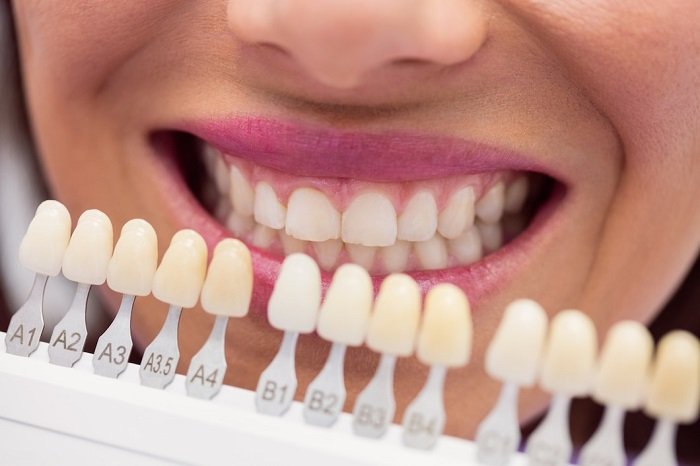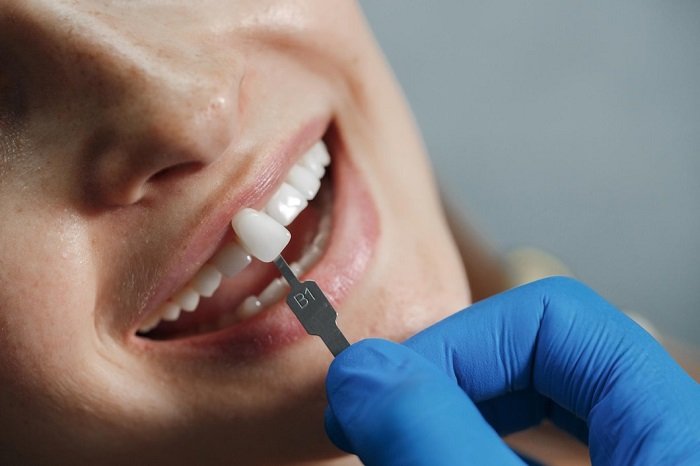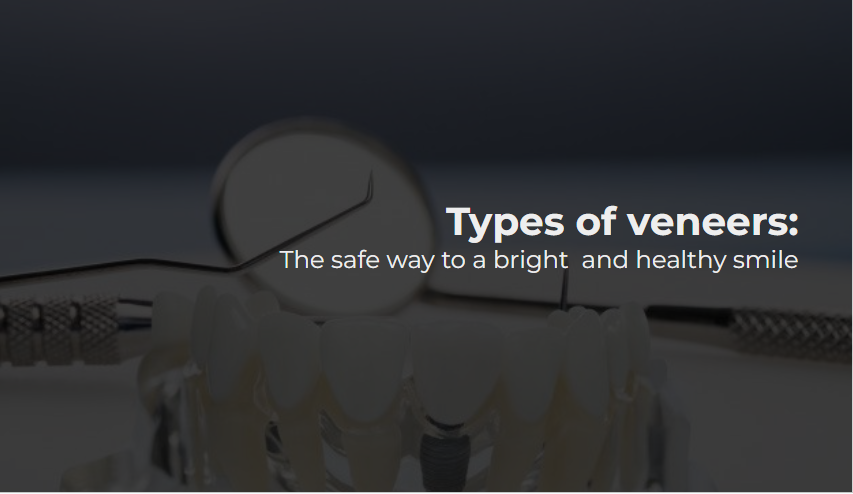Brushing your teeth can be one way to achieve a whiter smile, but what can you do if there are cracks or discoloration on your teeth that will not go away? One method is using veneers, which will go over your teeth and seamlessly blend, boosting your confidence in your smile. Read on to find out the types of materials veneers can be made of.
What are dental veneers?
Dental veneers are shells that are placed over the surface of your teeth. They are cosmetic in nature and can conceal various aesthetic imperfections, such as cracks, gaps, chips, tooth discoloration, smaller-than-average teeth, and more. Often these veneers are made of high-quality dental materials, such as resin-composite, porcelain, or ceramics.
When a tooth is cracked or chipped, some people may only get one veneer, but more often than not, many people decide to get six to eight veneers so they can get a uniform, symmetrical smile. Usually, people apply teeth veneers to the top eight front teeth.
Types of dental veneers
The most popular materials for dental veneers are porcelain or composite resin, which require extensive preparation. However, there are also “no-prep” veneers, which are applied using a different method.
When applying dental veneers, the tooth structure often needs to be ground down, perhaps even past the enamel. This enables accurate placement, but the irreversible procedure can also be painful, so it frequently necessitates a local anesthetic.
The amount of reduction is determined by your dental concerns and how many teeth dental veneers will be applied. A dentist may order a wax model when multiple teeth get veneers to demonstrate how veneers will appear.

Composite veneers
First, let us discuss composite veneers, which are able to hide minor visual flaws on your teeth. To create the desired effects, the dentist utilizes tooth-colored composite resin, which is the same substance used for dental bonding (unlike veneers, dental bonding can be reversed).
People often prefer composite veneers because they are more affordable compared to the other types. Additionally, frequently they can be applied in a single procedure, eliminating the need for many dental appointments. Additional benefits of this type of veneer include:
- Requiring less tooth preparation
- Costing about half of what porcelain veneers cost
- If they are high-quality, they can also look natural
However, a disadvantage of composite veneers is that they are also more likely to chip, break, or stain. So then, how long do composite veneers last? Usually, the lifespan of composite veneers is about five years.
How it is Applied: composite veneers
If you decide on composite resin veneers, there are two ways the veneer can be applied: direct and indirect. For the first type, your dentist will etch the tooth’s surface before coating it with a thin layer of composite material. Achieving the look you desire may take several layers of composite. Afterward, the dentist will harden the composite using a special light.
With indirect composite veneers, the veneers are created “indirectly” in a dental lab or at your dentist’s clinic (in other words, outside of your mouth). Until these veneers are entirely ready, you will be given a set of temporary veneers. The indirect composite veneers will then be placed on your teeth with a coat of adhesive at your next visit.
Indirect composite veneers have greater abrasion and fracture resistance than their direct counterparts. However, due to this, they often cost more as well.
Porcelain veneers
Porcelain veneers can help improve a variety of aesthetic flaws. These veneers are made specifically for your dental structure. Similar to the other types, your dentist will need to remove some enamel from your natural teeth before placing it. This step makes the surfaces of your teeth rougher and aids in retaining your new veneers.
Porcelain veneers are most often chosen by those who wish to make small changes to their teeth, like changing the tooth shape, color, or size. A few advantages of porcelain veneers include:
- Being thinner than others
- Having a more natural tooth appearance
- Lasting up to 15 years if properly taken care of
- Most of the time, the natural tooth does not need to be shaved down
However, due to these benefits, they also cost more and need a special polishing paste. In addition, in case they break, you will have to get a replacement, as they cannot be repaired.

How it is applied: porcelain veneers
For porcelain veneers, before making a mold of your teeth, some dentists will first grind your teeth down. Afterward, the mold will be sent to a lab to create the custom porcelain veneers.
Once the porcelain veneer is prepared, the dentist can apply it to the prepped tooth and secure it in place. Like the indirect composite veneers, temporary veneers may be worn until the permanent veneers return from the lab.
Another method of making the veneers is through CAD/CAM technology, where a computer can design the veneer. In other words, the dentist can make the veneers directly in the office
How much do porcelain veneers cost in Australia?
The cost of veneers in Melbourne can vary depending on the type of veneers you prefer, the brand your dentist has available, and the dentist’s level of expertise. In Melbourne, porcelain veneers are often on the expensive side, with prices usually ranging from $1800 to $2500+ per tooth. However, it’s worth noting that there are dental clinics in Melbourne that offer a variety of payment plans and discounts. Therefore, if you’re in Melbourne, you may be able to find porcelain veneers that fit your budget.
Similarly, the cost of veneers in Sydney can also vary depending on the type of veneers you prefer, the brand your dentist has available, and the dentist’s level of expertise. In Sydney, porcelain veneers are often on the expensive side as well, with prices usually ranging from $1800 to $2500+ per tooth. However, it’s worth noting that there are dental clinics in Sydney that offer a variety of payment plans and discounts. Therefore, if you’re in Sydney, you may be able to find porcelain veneers that fit your budget.
Thus, the cost of ceramic veneers will not vary significantly from state to state.
Ceramic veneers
The third type is ceramic veneers, which are somewhat similar to porcelain veneers. Ceramic veneers require less preparation than porcelain veneers but can take longer to create. Nevertheless, thanks to their natural appearance and durability, they are among the most popular types. They utilize bio-inert ceramic materials that are resistant to bacterial infection, like zirconia. Also, instead of being milled, these veneers are synthesized, reducing the natural teeth’ prep time and contouring.
Takeaway
Veneers can help you regain your confident smile. The main types of veneers are made of porcelain or composite resin, and the application of the latter type can be indirect or direct. They each have their advantages and disadvantages. Porcelain veneers are longer lasting and more durable, but also more expensive. On the other hand, compost veneers are more affordable but do not have a long lifespan. Whichever one you choose, make sure to communicate your needs with your dentist before fully committing, as the process is often irreversible.


